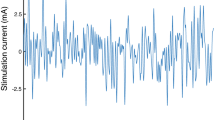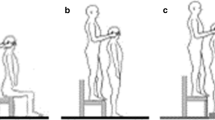Abstract
The adoption of bipedalism by hominids including man has complicated the tasks of balance control and the minimisation of body sway. We have investigated the role of the vestibular organs in controlling sway in the roll direction using galvanic vestibular stimulation (GVS). Two stance conditions were studied: during forward lean posterior compartment muscles are activated and during backward lean anterior compartment muscles are activated. GVS-evoked vestibular signals in stance control leg muscles as a group: all the active muscles in the leg on the GVS cathode side are excited together and those in the contralateral leg (anode side) relax. The subject sways towards the anode side. During treadmill walking, vestibular actions are subtly different: the actions are largely restricted to muscles acting at the ankle joint, occur at longer latencies, are not reciprocal in the opposite limb, are modulated throughout the step cycle (largest early in stance) and are reversed in sign in the peroneus longus muscle. The subject deviates towards the anode side. Hand contact with a firm object reduces GVS-evoked responses in leg muscles during treadmill walking. Responses to GVS are observed during over-ground walking but not significantly during bicycling on an ergometer. The observations suggest that these vestibular actions are part of a roll stabilisation mechanism. They may be mediated through different spinal premotor mechanisms during standing and walking and turned off during bicycling, when leg muscles have no balance control function.











Similar content being viewed by others
References
Ali AS, Rowen KA, Iles JF (2003) Vestibular actions on back and lower limb muscles during postural tasks in man. J Physiol 546:615–624
Bauby CE, Kuo AD (2000) Active control of lateral balance in human walking. J Biomech 33:1433–1440
Bent LR, Inglis JT, McFadyen BJ (2004) When is vestibular information important during walking? J Neurophysiol 92:1269–1275
Brandt T, Strupp M, Benson J, Dieterich M (2001) Vestibulopathic gait. Walking and running. Adv Neurol 87:165–172
Britton T, Day B, Brown P, Rothwell J, Thompson P, Marsden C (1993) Postural electromyographic responses in the arm and leg following galvanic vestibular stimulation in man. Exp Brain Res 94:143–151
Capaday C, Lavoie BA, Barbeau H, Schneider C, Bonnard M (1999) Studies on the corticospinal control of human walking. I. Responses to focal transcranial magnetic stimulation of the motor cortex. J Neurophysiol 81:129–139
Cappellini G, Ivanenko YP, Poppele RE, Lacquaniti F (2006) Motor patterns in human walking and running. J Neurophysiol 95:3426–3437
Cathers I, Day BL, Fitzpatrick RC (2005) Otolith and canal reflexes in human standing. J Physiol 563:229–234
Cohen HS (2000) Vestibular disorders and impaired path integration along a linear trajectory. J Vestib Res 10:7–15
Courtine G, Schieppati M (2003) Human walking along a curved path. II. Gait features and EMG patterns. Eur J Neurosci 18:191–205
Courtine G, Papaxanthis C, Schieppati M (2006) Coordinated modulation of locomotor muscle synergies constructs straight-ahead and curvilinear walking in humans. Exp Brain Res 170:320–335
Davies H, Edgley S (1994) Inputs to group II-activated midlumbar interneurones from descending motor pathways in the cat. J Physiol 479:463–473
Day BL, Cole J (2002) Vestibular-evoked postural responses in the absence of somatosensory information. Brain 125:2081–2088
Day BL, Severac Cauquil A, Bartolomei L, Pastor MA, Lyon IN (1997) Human body-segment tilts induced by galvanic stimulation: a vestibularly driven balance protection mechanism. J Physiol 500:661–672
Day BL, Guerraz M, Cole J (2002) Sensory interactions for human balance control revealed by galvanic vestibular stimulation. Adv Exp Med Biol 508:129–137
Deshpande N, Patla AE (2005) Dynamic visual-vestibular integration during goal directed human locomotion. Exp Brain Res 166:237–247
Dickstein R, Laufer Y (2004) Light touch and center of mass stability during treadmill locomotion. Gait Posture 20:41–47
Dickstein R, Peterka RJ, Horak FB (2003) Effects of light fingertip touch on postural responses in subjects with diabetic neuropathy. J Neurol Neurosurg Psychiatr 74:620–626
Dickstein R, Ufaz S, Dunsky A, Nadeau S, Abulaffio N (2005) Speed-dependent deviations from a straight-ahead path during forward locomotion in healthy individuals. Am J Phys Med Rehabil 84:330–337
Donelan JM, Shipman DW, Kram R, Kuo AD (2004) Mechanical and metabolic requirements for active lateral stabilization in human walking. J Biomech 37:827–835
Fitzpatrick RC, Wardman DL, Taylor JL (1999) Effects of galvanic vestibular stimulation during human walking. J Physiol 517:931–939
Goldberg JM, Smith CE, Fernandez C (1984) Relation between discharge regularity and responses to externally applied galvanic currents in vestibular nerve afferents of the squirrel monkey. J Neurophysiol 51:1236–1256
Holden M, Ventura J, Lackner JR (1994) Stabilization of posture by precision contact of the index finger. J Vestib Res 4:285–301
Iles J, Tanner R (2006) Limb muscle responses to vestibular stimulation during treadmill walking in man. Proc Physiol Soc 1:C5
Iles JF, Ali A, Pardoe J (2000) Task-related changes of transmission in the pathway of heteronymous spinal recurrent inhibition from soleus to quadriceps motor neurones in man. Brain 123:2264–2272
Iles JF, Ali AS, Savic G (2004) Vestibular-evoked muscle responses in patients with spinal cord injury. Brain 127:1584–1592
Iles JF, Baderin R, Simon A (2005) Short- and medium-latency responses to galvanic vestibular stimulation in human lower limb muscles during tonic and rhythmic motor behaviours. J Physiol 565P:C106
Inman V (1947) Functional aspects of the abductor muscles of the hip. J Bone Joint Surg 29:607–619
Jahn K, Strupp M, Schneider E, Dieterich M, Brandt T (2000) Differential effects of vestibular stimulation on walking and running. Neuroreport 11:1745–1748
Lackner JR, DiZio P (2005) Vestibular, proprioceptive, and haptic contributions to spatial orientation. Annu Rev Psychol 56:115–147
Langlet C, Leblond H, Rossignol S (2005) The mid-lumbar segments are needed for the expression of locomotion in chronic spinal cats. J Neurophysiol 93:2474–2488
Lund S, Broberg C (1983) Effects of different head positions on postural sway in man induced by a reproducible vestibular error signal. Acta Physiol Scand 117:307–309
Lyon IN, Day BL (2004) Predictive control of body mass trajectory in a two-step sequence. Exp Brain Res 161:193–200
MacKinnon CD, Winter DA (1993) Control of whole body balance in the frontal plane during human walking. J Biomech 26:633–644
Marsden JF, Castellote J, Day BL (2002) Bipedal distribution of human vestibular-evoked postural responses during asymmetrical standing. J Physiol 542:323–331
Marsden JF, Blakey G, Day BL (2003) Modulation of human vestibular-evoked postural responses by alterations in load. J Physiol 548:949–953
Matsuyama K, Drew T (2000) Vestibulospinal and reticulospinal neuronal activity during locomotion in the intact cat. I. Walking on a level surface. J Neurophysiol 84:2237–2256
Misiaszek JE, Stephens MJ, Yang JF, Pearson KG (2000) Early corrective reactions of the leg to perturbations at the torso during walking in humans. Exp Brain Res 131:511–523
Moore SP, Rushmer DS, Windus SL, Nashner LM (1988) Human automatic postural responses: responses to horizontal perturbation of stance in multiple directions. Exp Brain Res 73:648–658
Orlovsky GN (1972) The effect of different descending systems on flexor and extensor activity during locomotion. Brain Res 40:359–371
Pierrynowski MR, Smith SB (1996) Rear foot inversion/eversion during gait relative to the subtalar joint neutral position. Foot Ankle Int 17:406–412
Rademaker GGJ (1980) The physiology of standing (translation of Das Stehen, 1931). University of Minnesota Press, Minneapolis
Roberts T (1995) Understanding balance: the mechanics of posture and locomotion. Chapman & Hall, London
Siegel S (1956) Nonparametric statistics. McGraw Hill, New York
Tang P-F, Woollacott M, Chong R (1998) Control of reactive balance adjustments in perturbed human walking: roles of proximal and distal postural muscle activity. Exp Brain Res 119:141–152
Tokuno CD, Carpenter MG, Thorstensson A, Cresswell AG (2006) The influence of natural body sway on neuromuscular responses to an unpredictable surface translation. Exp Brain Res 174:19–28
Ward CV (2002) Interpreting the posture and locomotion of Australopithecus afarensis: where do we stand? Am J Phys Anthropol Suppl 35:185–215
Winter DA (1991) The biomechanics and motor control of human gait: normal, elderly and pathological. Waterloo Biomechanics, Waterloo
Winter DA (1995) Human balance and posture control during standing and walking. Gait Posture 3:193–214
Zollikofer CPE, Ponce de Leon MS, Lieberman DE, Guy F, Pilbeam D, Likius A, Mackaye HT, Vignaud P, Brunet M (2005) Virtual cranial reconstruction of Sahelanthropus tchadensis. Nature 434:755–759
Acknowledgment
This work has been supported by the International Spinal Research Trust.
Author information
Authors and Affiliations
Corresponding author
Rights and permissions
About this article
Cite this article
Iles, J.F., Baderin, R., Tanner, R. et al. Human standing and walking: comparison of the effects of stimulation of the vestibular system. Exp Brain Res 178, 151–166 (2007). https://doi.org/10.1007/s00221-006-0721-2
Received:
Accepted:
Published:
Issue Date:
DOI: https://doi.org/10.1007/s00221-006-0721-2




